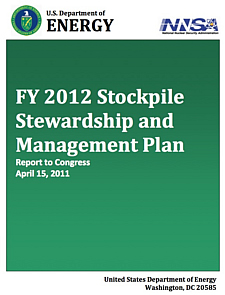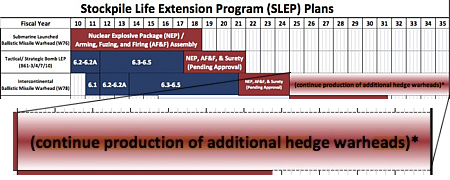 |
| Click on image to download document. |
.
By Nickolas Roth, Hans M. Kristensen and Stephen Young
Note: This is the fourth of four posts analyzing the FY 2012 Stockpile Stewardship and Management Plan, each jointly produced by the Federation of American Scientists and Union of Concerned Scientists. See previous posts: 1, 2, 3.
The FY2012 SSMP repeats the promise made in numerous previous government documents and official statements: construction of new factories with greater warhead production capability might enable retirement of some “hedge” warheads after the “responsive complex” has come online in the early-2020s and thereby reduce the overall size of the stockpile.
Today, the United States has approximately 2,150 operational warheads and another 2,850 in the hedge, for a stockpile total of 5,000. The FY2011 SSMP stated (Annex D, p. 2) that the planned production complex would be able to support a stockpile of 3,000-3,500 warheads, a level 1,500-2,000 warheads below today’s stockpile. However, it did not provide a timetable or strategy for any such reductions.
The FY2012 SSMP does, however, place conditions on further reductions. The report states that the number of nuclear weapons in the nation’s stockpile “may be reduced…if planned LEPs are completed successfully, the future infrastructure of the NNSA enterprise is achieved, and geopolitical stability permits” (emphasis added). The first two items on this list will not be accomplished for at least twenty years, but the plan shows that production of “hedge” warheads will continue even after that.
Specifically, the FY2012 SSNP states that this new production capacity is required “regardless of the size of stockpile” and shows that NNSA now plans to produce W78 hedge warheads during the 2021-2024 W78 LEP and even “continue production of additional hedge warheads” through 2035.
| NNSA Plans Production of More Hedge Warheads |
 |
| Despite a promise that construction of new warhead production facilities will permit a reduction of the “hedge” of non-deployed warheads in the stockpile, the FY2012 SSMP shows that the new facilities will be used to produce “additional hedge warheads.” The key phrase is enlarged above. Click on image to see the original. |
.
The chart hints that hedge warhead production might also be part of the other warhead LEPs in the NNSA plan. The reason for the additional W78 hedge production in 2025-2035 is not stated. Right now, there are approximately 600 W78s in the stockpile, of which 350 are in the hedge. Are they planning to increase the latter number? Or is that simply continuing production of the “common or adaptable” warhead that would be actually used in the W88 LEP later on? Have other LEPs not been performed on warheads in the hedge, but they will here? The answer is a mystery.
Yet the use of new warhead production facilities to produce additional hedge warheads undermines the administration’s message that the new facilities are needed to allow a reduction of the stockpile. It suggests that even with a new “responsive” warhead production complex, the future stockpile will still include a sizeable hedge of reserve warheads.
Additionally, although the SSMP states that these facilities are needed to “maintain a safe, secure, and reliable arsenal over the long term,” these facilities will not be operational until most of the currently planned Life Extension Programs are either completed or well underway. That makes the plan to use the new facilities to produce additional hedge warheads particularly problematic.
About the authors: Nickolas Roth is Policy Fellow for the Center for Arms Control and Non-Proliferation and a graduate student at the University of Maryland, Hans M. Kristensen is the Director of the Nuclear Information Project at the Federation of American Scientists, and Stephen Young is a Senior Analyst at Union of Concerned Scientists.
This publication was made possible by a grant from Carnegie Corporation of New York and Ploughshares Fund. The statements made and views expressed are solely the responsibility of the author.
The FY2026 National Defense Authorization Act (NDAA) paints a picture of a Congress that is working to both protect and accelerate nuclear modernization programs while simultaneously lacking trust in the Pentagon and the Department of Energy to execute them.
While advanced Chinese language proficiency and cultural familiarity remain irreplaceable skills, they are neither necessary nor sufficient for successful open-source analysis on China’s nuclear forces.
Satellite imagery has long served as a tool for observing on-the-ground activity worldwide, and offers especially valuable insights into the operation, development, and physical features related to nuclear technology.
This report outlines a framework relying on “Cooperative Technical Means” for effective arms control verification based on remote sensing, avoiding on-site inspections but maintaining a level of transparency that allows for immediate detection of changes in nuclear posture or a significant build-up above agreed limits.